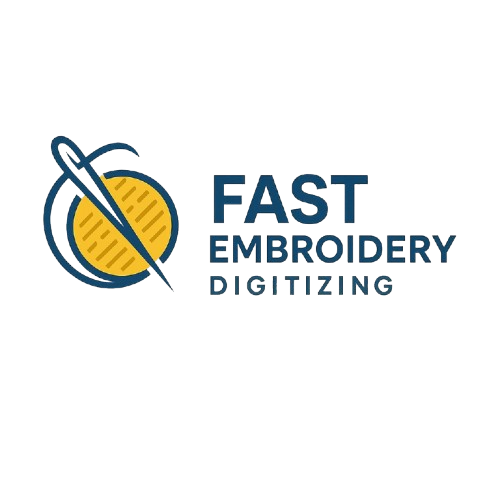Embroidery has evolved from a traditional handcraft into a precise digital art form powered by technology. At the center of this transformation is embroidery digitizing, the process that turns digital artwork into machine-readable stitch files. Whether you are an embroidery professional, apparel manufacturer, or creative designer, understanding the key terms used in embroidery digitizing is essential for achieving consistent, high-quality results.
This comprehensive guide — key terms in embroidery digitizing explained — defines and explains the essential vocabulary you’ll encounter in modern embroidery production. Each term represents an important part of the digitizing workflow, helping you better understand how digital designs become professional embroidered products.
Understanding Embroidery Digitizing
Embroidery digitizing is the process of converting artwork, such as a logo or design, into a digital file that embroidery machines can interpret. The file contains instructions that control stitch type, direction, density, color order, and movement. Digitizing is both a science and an art — it requires technical precision and a deep understanding of fabric, thread, and machine behavior.
Without proper digitizing, even the most advanced embroidery machine cannot produce clean, balanced results. Every term used in digitizing contributes to understanding how the process works, ensuring that embroidered designs are visually appealing, durable, and consistent across various garments.
Artwork
Artwork is the foundation of every embroidery project. It refers to the original image or design that needs to be digitized. The quality and format of the artwork determine how well it can be converted into stitches. High-resolution or vector files (such as AI, EPS, or SVG) are preferred because they produce sharp, clean edges that translate accurately during digitizing.
Digitizers often simplify or adjust artwork before converting it into stitches to maintain clarity and avoid overcrowding. A well-prepared artwork ensures that every element — from tiny letters to complex logos — stitches correctly on fabric.
Stitch
A stitch is the basic unit of embroidery. It is formed when a needle and thread penetrate the fabric in a specific pattern. The digitized file controls the placement and length of each stitch, determining the overall appearance and texture of the design.
In embroidery digitizing, different stitch types are used to achieve varied effects. The three most common are satin stitches (for letters and outlines), fill stitches (for large filled areas), and running stitches (for outlines and small details). The right stitch type ensures the design looks professional and runs smoothly on embroidery machines.
Underlay
Underlay refers to the foundation layer of stitches placed beneath the main design. It stabilizes the fabric, prevents distortion, and provides support for the top stitches. Underlay is often invisible in the finished embroidery but plays a crucial role in ensuring clean results.
There are different types of underlay: edge-run for delicate fabrics, zigzag for medium-weight materials, and double zigzag for thick or textured fabrics. The correct underlay type helps the design maintain its shape and prevents the top layer from sinking into the material.
Density
Density refers to how closely stitches are placed together in a design. It determines how thick or smooth the embroidery looks. If the stitches are too dense, the design becomes stiff, and threads may break. If the density is too low, the fabric shows through, making the embroidery look incomplete.
The right density depends on the fabric type and the thread weight. For example, lightweight fabrics like polyester require lower density, while heavy fabrics like denim can support higher density. Adjusting stitch density ensures that embroidery looks clean and remains flexible.
Pathing
Pathing, or stitch sequencing, is the order in which an embroidery machine stitches different parts of a design. A digitizer decides how the needle moves across the design to minimize jumps, trims, and stops. Proper pathing improves efficiency, saves thread, and reduces production time.
Well-planned pathing ensures that the design runs smoothly without leaving unnecessary thread trails or misalignments. It also affects how different colors and layers overlap, influencing the final look of the embroidery.
Compensation
Compensation is the adjustment made to counteract the natural distortion caused by stitching. During embroidery, the tension of the thread can stretch or pull the fabric, causing letters or shapes to lose proportion. Compensation corrects this by slightly expanding or contracting stitch placement so the finished design matches the original artwork.
Without proper compensation, circular shapes may appear oval, and text may look uneven. Skilled digitizers apply the right amount of compensation based on the fabric’s stretch and the stitch type being used.
Stitch Count
Stitch count is the total number of stitches in an embroidery design. It directly affects production time, cost, and thread usage. A higher stitch count means a more detailed and dense design, while a lower stitch count indicates a simpler, lighter design.
Embroidery companies in the USA often use stitch count to determine pricing. Efficient digitizing minimizes unnecessary stitches without sacrificing design quality, making production faster and more cost-effective.
Thread Tension
Thread tension refers to the balance between the top and bottom (bobbin) threads during stitching. If the tension is too tight, threads may break or pucker the fabric. If it’s too loose, loops or uneven stitches may appear.
Good digitizing helps maintain proper tension by ensuring even stitch direction and smooth thread flow. Machine operators also adjust tension settings based on fabric type and thread thickness to achieve consistent results.
File Formats
Embroidery machines read specific file formats that contain stitch instructions. Each brand uses its own preferred format. The most common include DST (Tajima), PES (Brother and Babylock), EXP (Melco and Bernina), and JEF (Janome).
Digitizers provide files in multiple formats to ensure compatibility with different embroidery machines. Using the correct file type guarantees that the machine interprets color changes, stitch directions, and thread commands accurately.
Hooping
Hooping is the process of securing the fabric in an embroidery hoop or frame before stitching. The hoop keeps the fabric taut, ensuring stability and alignment during embroidery. Improper hooping can cause shifting, misaligned stitches, or puckering.
Professional embroiderers use the right hoop size and tension to match the fabric type and design size, achieving clean and consistent results.
Push and Pull Effect
The push and pull effect refers to the natural movement of fabric during embroidery. As the needle and thread move, the fabric tends to stretch (push) or contract (pull). This can cause distortions in shapes and outlines if not properly managed.
Digitizers compensate for this effect by adjusting stitch placement, direction, and density. Understanding the push and pull behavior of different fabrics helps maintain design accuracy.
Satin Stitch
Satin stitches are smooth, glossy stitches commonly used for text, borders, and small shapes. They add shine and texture, making them ideal for logos and lettering. However, they are best used for narrow areas; when applied to large spaces, they may appear uneven.
The width, angle, and density of satin stitches are adjusted during digitizing to maintain uniformity and prevent thread breaks.
Fill Stitch
Fill stitch, also known as tatami stitch, is used to cover large areas of embroidery. It creates texture and depth while maintaining flexibility. The direction of fill stitches can be varied to add visual contrast and dimension to the design.
Fill stitches are especially useful in patch embroidery, background areas, and complex patterns where uniform coverage is required.
Running Stitch
Running stitches form continuous lines used for outlines, fine details, or connecting different design parts. They use minimal thread and are essential for small or intricate embroidery elements. Running stitches also serve as underlay or placement lines in multi-layer designs.
Sequencing
Sequencing determines the order in which each section or color of a design is stitched. Correct sequencing ensures smooth operation, reduces color changes, and maintains proper layering of overlapping elements.
If sequencing is not well planned, designs can appear uneven, and threads may overlap incorrectly. Professional digitizers plan sequencing to balance efficiency with visual accuracy.
Importance of Learning Embroidery Terms
Understanding these key terms in embroidery digitizing explained helps both beginners and professionals communicate effectively with clients, digitizers, and machine operators. Each term influences how designs are interpreted, produced, and finished.
For businesses, this knowledge ensures that orders are precise, production is efficient, and customer expectations are met. For digitizers and designers, mastering these terms enhances creativity while maintaining technical accuracy.
Final Thoughts
The modern embroidery industry in the USA thrives on precision and professionalism. Knowing the key terms in embroidery digitizing explained empowers you to navigate every stage of the process — from artwork preparation to final production — with confidence.
Every term, from stitch density to underlay, plays an essential role in determining how digital art transforms into embroidered excellence. By mastering these concepts, you not only improve your technical understanding but also elevate the overall quality of your embroidery work.
Whether you’re running a large embroidery shop or starting a creative venture, familiarity with these digitizing terms will help you produce designs that are efficient, durable, and visually stunning — true reflections of skill and craftsmanship in every thread.



